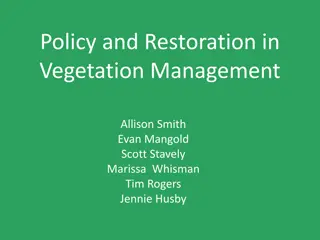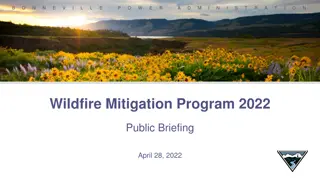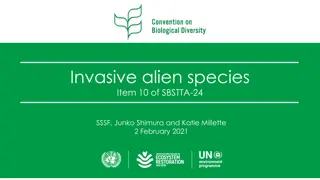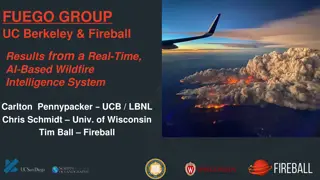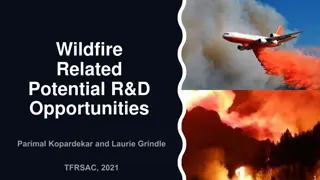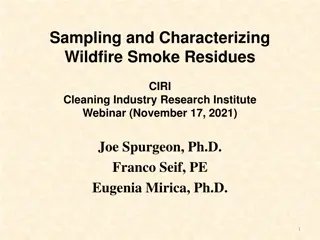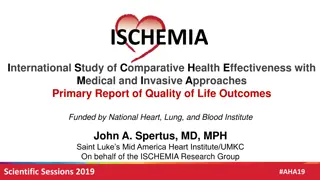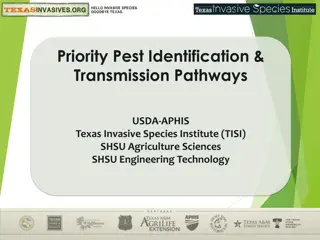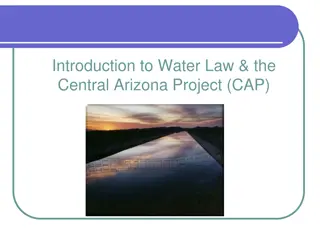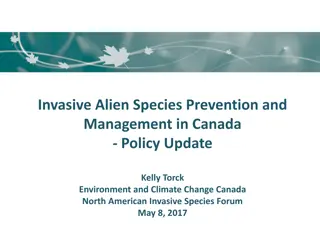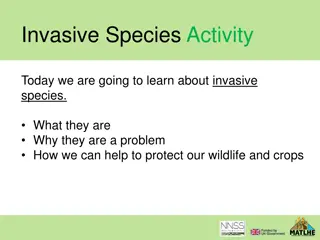Managing Invasive Plants and Wildfire in Arizona
The Invasive Plant Grant Program in Arizona is actively combating invasive plant species to prevent wildfires and preserve ecosystems. State funds are allocated for projects targeting species like Saltcedar and Buffelgrass. Grant criteria and projects in 2019 and 2020 reveal a focus on eradicating non-native vegetation through removal, revegetation, and monitoring efforts. Various organizations are involved in projects across different regions, receiving grants for tackling specific target species. Themes include riparian areas, with funding available for eligible costs and applicants. The program aims to reduce the impact of invasive plants on wildfire risk and biodiversity in Arizona.
Download Presentation

Please find below an Image/Link to download the presentation.
The content on the website is provided AS IS for your information and personal use only. It may not be sold, licensed, or shared on other websites without obtaining consent from the author. Download presentation by click this link. If you encounter any issues during the download, it is possible that the publisher has removed the file from their server.
E N D
Presentation Transcript
Invasive Plants and Wildfire in Arizona WILLIE SOMMERS INVASIVE PLANT PROGRAM COORDINATOR OCTOBER 8, 2020
Overview Invasive Plant Grant Program Weeds as a biological wildfire Wildfire prevention through fuels reduction What to do post fire Opportunities for the future
Invasive plant grant program Addition of state funds In 2019, per ARS 37-1309, the nonnative vegetation species eradication fund was established consisting of legislative appropriations for DFFM to provide grants For the 2019 grant cycle, there was $2M available for invasive plant projects; 11 projects were funded and have begun For the 2020 grant cycle and beyond, there will be $1M available each year through 2029 Giant reed (Arundo donax) in Marana
2019 IPG projects now underway Primary target species: Saltcedar (5 projects) Buffelgrass (2 projects) Johnsongrass (1 project) Other targets Diffuse knapweed, giant reed, oleander, stinknet, yellow bluestem
Grant criteria IPG criteria 2020 grant cycle (completed) Funds available $970,000 Theme Riparian areas Matching funds Minimum of 10% Project duration Up to 3 years Grant request $10,000 - $300,000 Eligible costs Invasive plant removal/treatment, revegetation with native plants, maintenance, monitoring Eligible applicants Local government, state agencies, non profit organizations, Tribes, universities
2020 IPG projects Grantee Location / Target species Grant award amount National Forest Foundation Lower Salt River / Saltcedar, giant reed, stinknet $200,000 Friends of the Verde River Verde River / Saltcedar, giant reed and others $193,298 Graham County Upper Gila River / Saltcedar $192,950 Arizona Game and Fish Department Lower Gila River / Saltcedar $190,000 Maricopa County Parks and Recreation Department Cave Creek / Saltcedar and others $87,000 Friends of Saguaro National Park Tanque Verde Creek / Fountain grass $83,000 Sky Island Alliance Aravaipa Creek / Vinca $20,000
IPG prioritization Year Theme Example target species 2020 Riparian areas Saltcedar, tree of heaven, Russian olive, giant reed 2021 Emerging threats Stinknet, vinca, yellow bluestem 2022 Forests and woodlands Dalmatian toadflax, diffuse knapweed, scotch thistle 2023 Aquatic habitat Giant salvinia, floating water hyacinth, hydrilla 2024 Grasslands Lehmann s lovegrass, yellow bluestem, Johnsongrass
Weeds as a biological wildfire Invasive noxious weeds have been described as a biological wildfire out of control and spreading rapidly (Dewey 1995) Wildfires and weeds share much in common, including impacts, spread, and management Wildfire temporary impacts; recovery occurs Weeds often long-term or permanent impacts; weeds remain on site and multiply Spread is similar too; weed seeds are like embers that ignite spot fires
Elements of effective management WILDFIRES WEEDS 1. Prevention 1. Prevention 2. Detection 2. Detection 3. Suppression 3. Control 4. Site rehabilitation 4. Revegetation
Prevention First line of defense Lands not presently infested can be prioritized Do we currently think about this? Education Desert Defenders program in the Phoenix area; Invasive Plants Ranger Program in the Flagstaff area; Sonoran Desert Weedwackers in Tucson; info graphics and other means of improving public awareness Regulation State-listed Noxious Weeds and associated restrictions per the Arizona Department of Agriculture (Class A, B and C Noxious Weeds); list updated in 2019
Detection Early detection is key Proper identification especially true for plants like thistles is it a native wildflower or a non-native noxious weed? Timely reporting and mapping Can the invasive plant be removed when it s initially detected? EDRR early detection, rapid response
Suppression (control) Four step process for fire fighters 1. Rapid response also called initial attack (IA) in the fire world 2. Size-up developing the best plan of attack 3. Containment stopping further spread, knowing the direction of spread, and putting out spot fires outside of a containment zone 4. Mop-up find and extinguish every live ember in a containment zone. In the weeds world, this means eradication of every plant or every seed. This could take a few days on a wildfire but a few years on a noxious weed infestation
Suppression (control) RAPID RESPONSE CONTAINMENT
Revegetation Active vs. passive revegetation Reseeding or container stock, use of tall pot plants to improve establishment Irrigation Herbivory protection Secondary weed control Climate change scenarios Genetic variability Photo courtesy of Yuma Crossing National Heritage Area
Wildfire prevention fuels reduction WILDFIRE PREVENTION FUELS REDUCTION Protect critical infrastructure (e.g., bridges) Values at risk communities, homes, utility corridors, water supplies, sensitive wildlife habitat Defensible space reduces fire danger when wildfire comes Zone 1 = 30 feet of lean, clean and green Zone 2 = 100 feet of reduced fuel
Desert invaders fuel for wildfire Biggest offenders are: Stinknet (Oncosiphon piluliferum) Saltcedar (Tamarix spp.) Malta starthistle (Centaurea melitensis) Buffelgrass (Penisetum ciliare) Fountain grass (Penisetum setaceum) Red brome (Bromus rubens) Sahara mustard (Brassica tournefortii) Mediterranean grass (Schismus barbatus)
What to do post-fire? California Native Plant Society Fire Recovery Guide (2019) Erosion evaluation: slope erosion and drainage erosion Vegetation recovery evaluation: degree of severity and biomass consumption Post-fire checklist for land care (landowners) Be patient. Lands have recovered many times after wildfires. Once human-made debris is removed, the land will heal on its own in most cases. It just needs time.
Opportunities for the future Citizen science and volunteers help with prevention and EDRR / reporting / mapping Fuel breaks & prescribed fires Managing fire for resource benefit Digging in and protecting special places (e.g., Aravaipa Canyon) Fire recovery guide for Arizona? Applying wildfire concepts to IPG projects Commitment and dedication Photo courtesy of the Arizona Wilderness Coalition


